|
Meemure, an idyllic tourist attraction:
Balancing: eco tourism and sustainability
By Gamini Warushamana
Tourism contributes to the economic development of the country with a
steady growth in tourist arrivals.
|
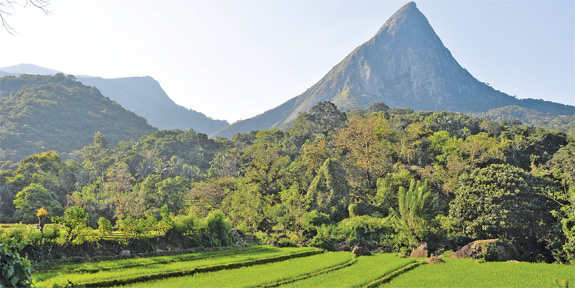
Lakegala, symbol of Meemure |
|
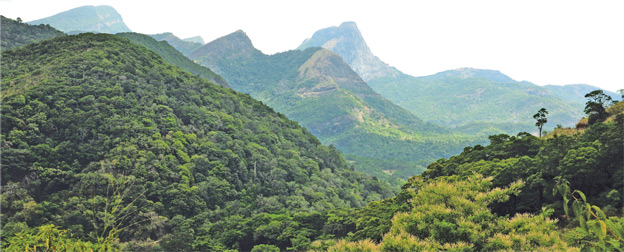 |
|
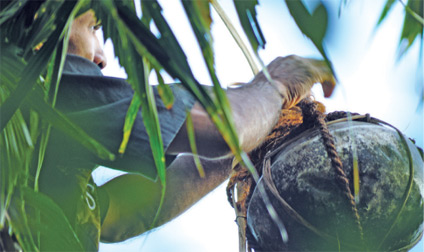
A pot of kithul sap |
According to official figures in the first two months of this year
288,453 tourists arrived recording a 28.5%, increase over the
corresponding period in 2013. In addition with a wider middle class and
changed lifestyles there is a huge flow of local tourists to the
countryside and as a result many remote villages have become tourist
attractions.
Meemure is one such village that has a relatively long history of
attracting nature lovers and during the New Year vacation thousands of
tourists visited Meemure.
With the vast influx of visitors and developing infrastructure new
challenges emerge over the sustainability of nature tourism in Meemure.
Dry winds were blowing fast across the Hunnasgiriya pass. The lonely
peak of Hunnasgiriya mountain remained green as usual resisting the
prevailing drought that has dried most of the vegetation in the mountain
range.
Hunnasgiriya is the main resting place of long distance travellers
along the Kandy-Mahiyangana road via the famous 18-elbow bends.
Restaurants and small tea kiosks, vegetable stalls, mobile sellers of
food items are the main businesses in this small town that connects
several small villages on the eastern slopes of the Knuckles mountain
range and the Dumbara valley.
By 11 am we were in Hunnasgiriya on transit to our destination,
Meemure, a famous attraction of nature lovers and adventure tourists.
We looked for public transport and got to know that the only van
which runs once a day up and down will start its return journey at 2.30
pm. Without wasting three and a half hours, we hired a tuk-tuk to travel
34 kilometres along extremely difficult, hilly terrain. The road
traversed through infertile tea plantations of Hare Park estate of the
Estate Plantation Corporation and the Knuckles forest range.
The area is not new to high-end tourists and there are several
expensive lodges and holiday resorts in the area for them. Some of them
are within the protected area of the forest and are therefore, illegal.
The huge gates of these hotels in the thick jungle with 'No Entrance'
boards seem mysterious and people in the area don't know what is
happening inside or who occupies them. New hotels are emerging to cater
to the increasing demand from local and foreign tourists.
The meditation centre of the Methsevena Foundation welcomes spiritual
visitors for meditation in the calm and beautiful environment.
Today, there is a dormitory and its owner, Charles Thomas said that
the 10 luxury rooms that are under construction will be allocated to
visitors of all religious beliefs for spiritual purposes.
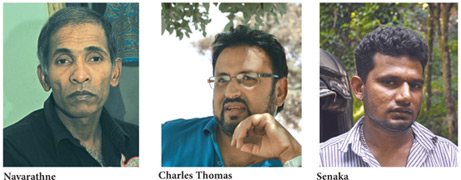 The rooms with large glass windows have been designed facing the East
to view the picturesque scenery at dawn from bed. It has facilities for
wheel-chaired elderly and sick people as well and Thomas said that this
will be an ideal place for meditation and the project is not
profit-oriented. The rooms with large glass windows have been designed facing the East
to view the picturesque scenery at dawn from bed. It has facilities for
wheel-chaired elderly and sick people as well and Thomas said that this
will be an ideal place for meditation and the project is not
profit-oriented.
The government has given prominence to the tourism industry in
economic development. However, if the industry is to achieve a positive
impact on the economy, the benefits should accrue to the people.
The high-end tourists coming through tour operators, stay in five
star hotels and travel by luxury buses owned by the same companies may
earn a higher revenue but there is no trickle down of benefits to the
people. This would lead to widening inequality in income distribution.
Tourism in Meemure is different in this sense and there are many
villagers who depend on it. Senaka Rajapaksa, the tuk-tuk driver we
hired is a classic example and he charged Rs. 3,000 for the trip to
Meemure.
He also works as the caretaker of a lodge with two family suits in
Kandegama, a village close to Hunnasgiriya and earns a monthly salary.
The lodge owner does the bookings and Rajapaksa looks after the
management side - cooking and care-taking of the lodge and he said that
with extra income from tips and hiring the tuk-tuk he earns a good
income.
P.D. Navarathne, a resident of Meemure was the first person in the
village to provide accommodation to tourists. Although there are not
many facilities in his house, he has two rooms to hire out and his wife
supplies the meals.
|
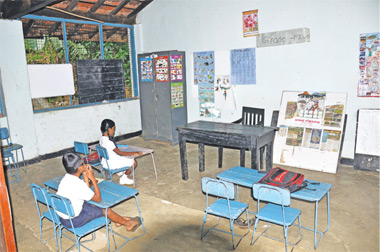
The school needs more teachers. |
He too has visitors on most days and specially during week-ends and
school vacations. Navarathna has expanded his business to new areas and
he now has camp sites and camping facilities for tourists. Although
there is no professionalism, he provides tourism experiences such as
trekking, hiking and bird watching.
Climbing Lakegala, the symbol of Meemure, is an exciting experience.
Mini world's end, trekking on a foot path along the Heen Ganga are other
interesting experiences here. Not only residents of Meemure, people
migrating from Colombo too have occupied land here and provide
accommodation for tourists at camp sites.
People complain that outsiders and their agents in the village have
already damaged the natural environment, the main tourist attraction.
The forest on the banks of the Heen Ganga, the main water stream in
the village, has been cleared for camp sites. The location of the famous
film Sooriya Arana too is a camp site today.
Villagers also complain about the irresponsible behaviour of visitors
under the influence of liquor, dump garbage and break the peaceful
existence of the peasants.
The main livelihood of the people in Meemure is agriculture and with
tourist attractions they have new opportunities. Village youth earn an
income as tourist guides.
Now they have a good market for Kithul products that they produce
such as jaggery and treacle. The Grama Niladhari of Meemure, A. Kelum
said that there are 115 households in the village and tourism has
created some employment opportunities for people.
The Meemure village captured public attention as the teledrama
location of Wanasarana. In 2002, the then Prime Minister Ranil
Wickremesinghe visited the area and was surprised by the hardships faced
by the people in this remote village. He pledged to develop
infrastructure and uplift the living conditions of the people.
However, nothing happened and according to another placard placed in
the middle of the village, construction work on the road was launched in
2006.
Although the road is still the same, the publicity given to these
political events highlighted the picturesque village to nature lovers
making Meemure a tourist attraction.
Road construction has now started from the Hunnasgiriya end and
people said that when the road is completed it would totally change
Meemure.
Some people have their reservations about how the road is being
constructed and those engaged in tourism said that the road should be
constructed without damaging the environment and are not happy with the
proposed road plan.
Charles Thomas said that if nature tourism becomes the main economic
activity, a different development model will have to be considered in
infrastructure development.
The village already has a different infrastructure model in power
generation. The village has its own mini hydro plant and dendro thermal
power plant provided by UNIDO.
The village is self-sufficient in electricity and last year hydro
power was available throughout the year. If hydro power is not
sufficient in the dry season, the dendro thermal power plant provides
electricity. It uses the fuel wood Gliricidia found abundantly in pepper
gardens.
The Electricity Consumer Society manages the power plants and charges
Rs. 250 monthly for electricity from each household. The natural
environment and water are the main sources that attract tourists here.
Most of the visitors enjoy the difficult journey which the villages hate
and are eager to see an end to it. Transport difficulties have isolated
the village from the rest of the world and deprived villagers from every
aspect of development. Education is a classic example.
The Meemure primary school has 21 students and classes are conducted
from Grades one to five but up to 2009 it had classes up to grade 9. But
there are only three teachers in the school including the principal and
if all three of them are present, at any given time, there are two
classes without a teacher.
With leave taken by teachers for personal reasons, training and
meetings of the principal at the regional education office in Kandy, the
situation becomes worse and as a result the school cannot provide a
proper education for students.
The same factors which attract visitors for pleasure have become a
burden to teachers sent to this school and they get transfers as quickly
as possible and leave the village.
The principal of the school, G. Jayarathne said that he needs at
least five teachers to provide a proper education and retaining of
teachers is extremely difficult and he cannot see a solution to it. |

